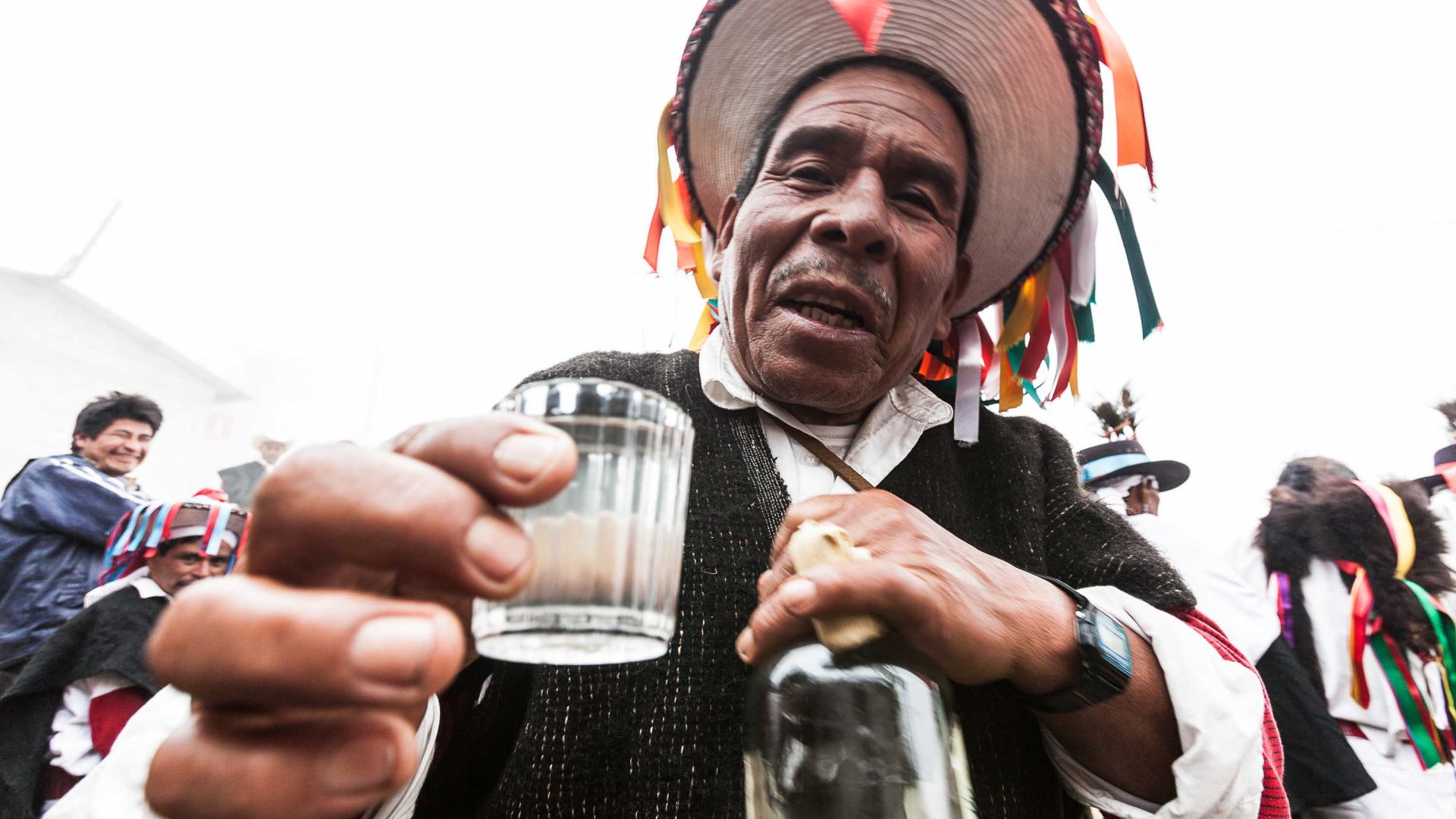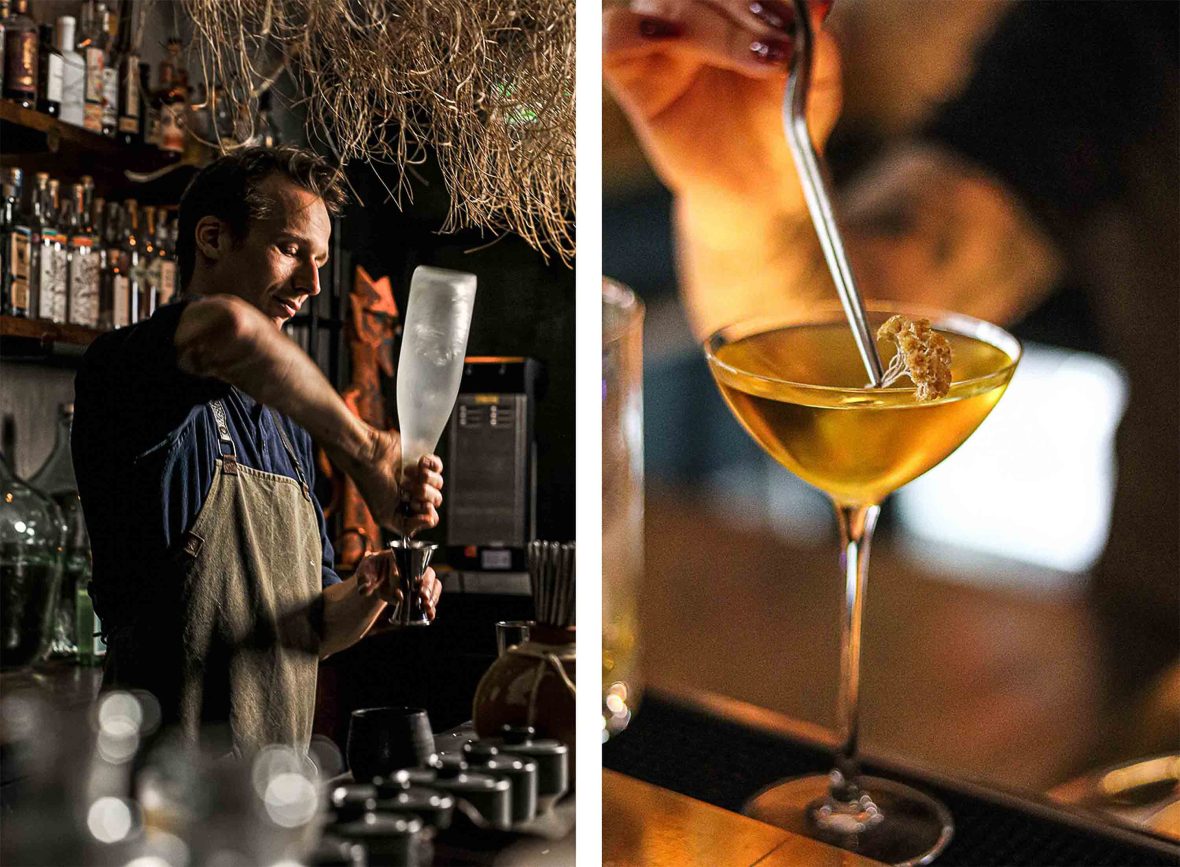
Once a closely guarded secret, pox (pronounced ‘posh’) is appearing in cocktail bars in Mexico and beyond. But is this ancient spirit coming for tequila’s crown? Charlotte McManus finds out.


Once a closely guarded secret, pox (pronounced ‘posh’) is appearing in cocktail bars in Mexico and beyond. But is this ancient spirit coming for tequila’s crown? Charlotte McManus finds out.
It’s late, and I’m wandering the cobbled streets of San Cristóbal de las Casas. Set in a valley surrounded by misty mountains and pine tree forests, this highland town forms part of Chiapas, the southernmost state of Mexico.
I pass colorful houses topped with wrought-iron crosses on red-tiled roofs, as papel picado (perforated paper) bunting flutters overhead, left over from Día de los Muertos festivities. Turning a corner, I stumble across something unexpected. An intimate space, crowded with bottles, filled with low laughter and candlelight. The perfume of burning copal tree resin lingers in the air, as hanging corn cobs twirl from the ceiling.
This is Posheria, a specialty shop serving pox (pronounced ‘posh’), an intriguing spirit rarely known—much less consumed—outside of Chiapas. Drawing up a stool at the bar, I’m presented with a glass of clear liquid served with coffee-dusted orange slices. The liquor is smooth, sweet and smoky, and quite unlike anything I’ve tasted anywhere else in Mexico.
It doesn’t remotely resemble tequila, or its cousin mezcal. No agave here. Instead, the smooth, rich profile is closer to rum, or perhaps whisky.
A measure (or two) later, I’m a little lightheaded—from the alcohol or the altitude, I can’t be sure. Gathering the fragments of my sketchy Spanish, I endeavor to find out more about this intriguing drink.
“Don Lorenzo grew very fond of me. He treated me like a son. One day, he gave me paper, on which was written the same pox recipe used by his ancestors.”
- Julio de la Cruz, Posheria
“Pox is very important in Mayan culture—a spiritual drink, a symbol of brotherhood,” says Julio de la Cruz, Posheria’s founder. “It is present in the ceremonies of the Indigenous communities. For them, this liquor acts as the bridge between the material world and the spiritual world.”
Invented by the Tzotzil Maya, pox has been used in rituals for centuries. Its name means ‘medicine’, or ‘cure’. A potent blend of distilled corn, sugar cane and wheat, this ancestral serve has a long heritage in Chiapas municipalities such as San Juan Chamula and Tenejapa, where it might be served with a coffee bean to chew on, or mixed with garlic and honey for medicinal uses. “Each sip fulfils a purpose,” De la Cruz tells me. “Pox is the promise of joy during the holidays, an elixir to cure body diseases, and a balm for the soul.”
Until just a few years ago, this ancient liquor was made solely for consumption among the Tzotzil, typically made at home behind closed doors. De la Cruz was an instrumental figure in bringing pox to a new generation of curious drinkers.
In 2010, he accompanied a tour guide friend, Alex Aranda, to Tenejapa. There, they were invited to a ceremony hosted by a mayordomo, the highest authority of the Indigenous community. “In a house illuminated with candles, we were welcomed with pox, served in a goat’s horn,” De la Cruz says. “In the mountains, surrounded by fog, we listened to traditional music, smelling the aroma of copal. It was an unforgettable experience—very magical, very mystical.”
De la Cruz was deeply moved by the encounter. “I was immediately captivated by this drink, with its flavor of toasted corn and a sweet touch of caramel,” he says. “I wanted to make it known to the world, to celebrate this special drink that brings hearts together.”
The entrepreneur opened Posheria that same year. To aid him in his dream of upholding pox tradition, Aranda introduced his friend to Don Lorenzo, majordomo of the San Juan Chamula community and a longtime pox maker. Before long, Loreno and De la Cruz struck up a close collaboration—and a warm friendship.

In 2013, Lorenzo fell ill. De la Cruz supported the mayordomo by buying him the expensive medications the elderly man could not afford otherwise.
“Don Lorenzo grew very fond of me. He treated me like a son,” the Posheria founder explains. “One day, he gave me paper, on which was written the same pox recipe used by his ancestors. I was moved to tears—he had made the gesture of sharing the recipe so that I could continue the tradition. Shortly after, Don Lorenzo passed away. I continue with the project in his honor.”
Championing the world’s first commercial pox at Posheria, the spirit comes in ‘ancestral’ (44 percent ABV) and double-distilled ‘tradicional’ (39 percent ABV) varieties, as well as the single-distilled ‘ceremonial’ pox (53 percent ABV), served with a cocoa truffle.
“Pox is an authentic representation of Mexico in liquid form, often described as ‘the liquid tortilla’ … Pox gives us the opportunity to immerse ourselves in the authenticity of Tzotzil traditions and witness their legacy in all its essence.”
- Isidoro Guindi, Siglo Cero co-founder
There are also sweeter digestifs (19.5 percent ABV) in flavors such as coffee, coconut, vanilla and cacao. Every liquor is entirely hand-made over the course of 28 days. In line with Tzotzil custom, the process begins during the new moon and concludes at the end of the lunar cycle.
Two years after Posheria opened, the Chiapas government relaxed laws prohibiting the sale of pox outside the state, leading the beverage to emerge in select bars across Mexico. Numerous bars now stock pox on the Riviera Maya (a few months after my San Cristobál trip, I sampled pox cocktails at a high-end beach resort), while in Ciudad de México, it can be found at the likes of Fifty Mils and Licorería Limantour.
“Pox has a silky flavor and texture and is easy to drink, since the alcohol is not predominant,” says Fátima León, star Mexican mixologist. Crowned Mexico’s Best Bartender, the Diageo World Class champion adapted pox into delicious serves during her tenure at Fifty Mils. “It is still niche, as only specialized places invest in having it on their menu, but it is a delicious spirit that is very worthy of exploration.”
Now, pox is gradually gaining prominence on the global stage. Though still rare, the last few years have seen pox make its way to the US and UK, where it is popping up at a handful of forward-thinking bars.
“Currently, there is a fascination with all things Mexican,” says Matthias Inglemann, group bar manager for the MJMK group, including KOL Mezcaleria in London. “Distribution is getting better too. At the same time, everyone is curious to discover new, unknown spirits. “Pox has many myths associated with it, which is of great interest.”
Siglo Cero is a name leading the charge on the international drinks scene. As the most widely distributed pox brand on the market, its slim bottles can be purchased internationally via online drinks outlets such as MexGrocer.
“Pox is an authentic representation of Mexico in liquid form, often described as ‘the liquid tortilla’,” says Siglo Cero co-founder, Isidoro Guindi. “It has preserved its traditional production methods over centuries, keeping its ancestral heritage alive. Its ties to rituals reflect the continuity of millennia-old practices that still endure today. Pox gives us the opportunity to immerse ourselves in the authenticity of Tzotzil traditions and witness their legacy in all its essence.”
Produced in San Juan Chamula, Siglo Cero is made from distilled white, red, yellow and black corn, sustainably grown by local Maya farmers using heritage strains. The brand helps to support the local communities who make it, through practices including fair pricing, resource provision, and improving working conditions. A portion of each sale is also donated to the ALSOL Foundation, dedicated to supporting artists and artisans in Chiapas.
“I drink it neat, paired with a chocolaty dessert. In a cocktail, pox is an interesting addition to an Old Fashioned, but I like it with a hint of sugar and mole bitters topped up with champagne.”
- Matthias Inglemann, head bartender, KOL Mezcaleria, London
Guindi founded Siglo Cero in 2014 as a collaborative venture with the Indigenous community. Early on, he struck up a relationship with brothers Jávier and Ángel Pérez. Members of the San Juan Chamula Tzotzil, they marked the seventh generation of a line of master pox craftspeople.
Theirs was a traditional recipe using the four colours of corn, a recipe which hadn’t been made for a long time due to limited costs and resources. Consequently, Ángel was “excited and supportive” at the notion that he would be able to return to “making the original recipe he loved so much,” with Siglo Cero’s backing.

Sadly, Ángel has since passed away, but Jávier continues to work with Siglo Cero as its master distiller. “It is pleasing to see pox becoming more popular, both nationally and internationally, as it means that the culture and tradition of pox is being shared and preserved,” says Pérez. “I find it very fulfilling to spread awareness and improve our pox with better quality, so that people can carry on the teachings of our ancestors.”
Pox can be enjoyed in a number of ways. De la Cruz and Léon prefer it straight up, like tequila. Guindi takes his one sip at a time, holding the glass in his left hand to “symbolize a connection to the heart”, alongside julienned jicama (Mexican turnip) sprinkled with Chiapaneco ground coffee. “I drink it neat, paired with a chocolaty dessert,” says Inglemann. “In a cocktail, pox is an interesting addition to an Old Fashioned, but I like it with a hint of sugar and mole bitters topped up with champagne.”
As for me, make mine a tradicional. Nothing beats that very first sip of ‘tradicional’ pox, perched on a rickety stool, senses suffused with the scent of copal, and that powerful taste of sweet, charred corn.
You can find out more about Posheria at posheria.mx or on Instagram @posheriasancristobal. Siglo Cero can be purchased at a variety of online vendors across the UK and US, including mexgrocer.co.uk
***
Adventure.com strives to be a low-emissions travel publication. We are powered by, but editorially independent of, Intrepid Travel, the world’s largest travel B Corp, who help ensure Adventure.com maintains high standards of sustainability in our work and activities. You can visit our sustainability page or read our Contributor Impact Guidelines for more information.

Charlotte is a freelance journalist specializing in travel, food and drink, and design. Based in London, though often globe-trotting, she was previously Associate Editor of Sphere and Editor of Raffles Hotels magazine. She is also a regular contributor to Wallpaper*. Now freelance and committed to responsible travel, travel plans include fall in Italy, New Year in Japan, and spring in South Africa.






Can't find what you're looking for? Try using these tags: